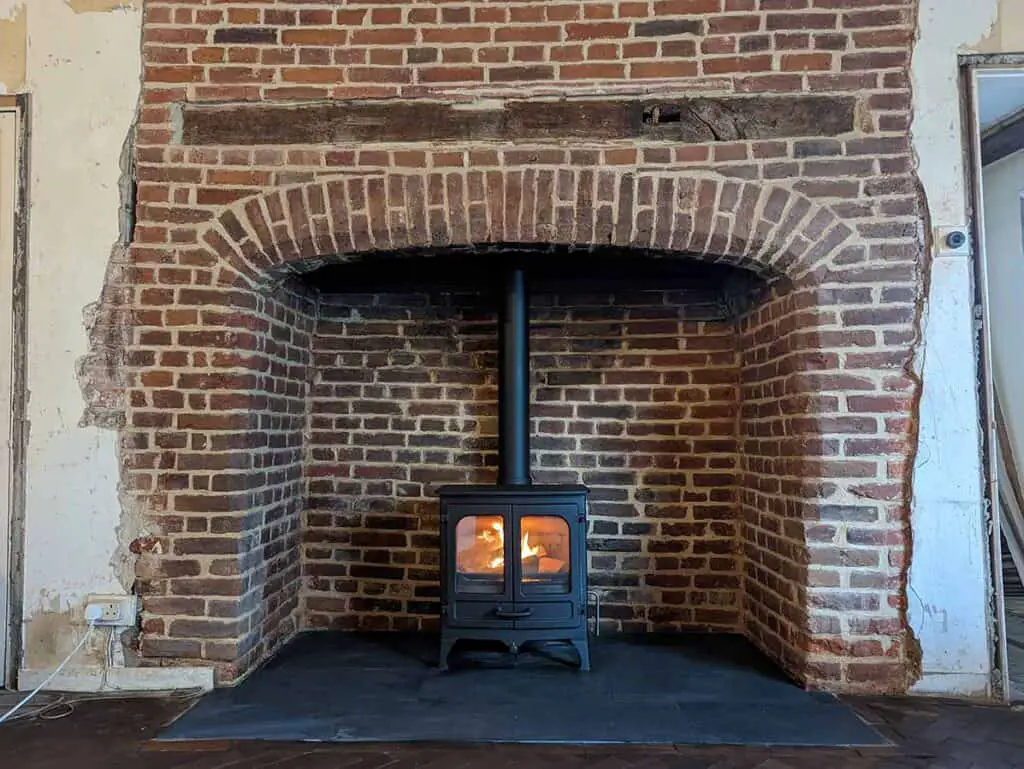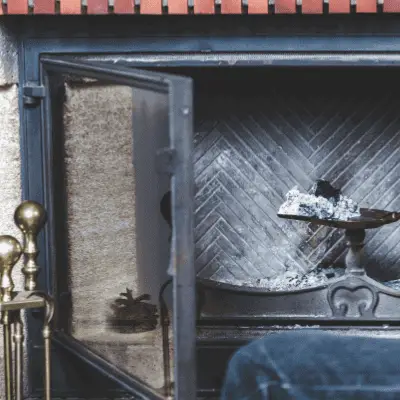Inglenook fireplaces have a place in most people’s hearts. And because of their size, Inglenooks are not only a talking point but can often be the selling point for a home.
But as they are generally found in older properties, Inglenooks can accrue considerable layers of soot over the decades (often centuries) they have been in use.
The big question for many inglenook inheritors is, can you clean it? The answer is: yes, you can. How easily you can clean your inglenook really depends on the size of the recess and how extensive the soot staining is.
There’s more than one type of Inglenook, however, so some cleaning methods won’t work as well as others if your inglenook is brick rather than stone. Don’t worry, though. We’ve got lots of ideas and various solutions for ways you can bring your inglenook back to looking its best.

How Do You Clean Stone in an Inglenook?
You’ve probably already tried soap and water and a considerable amount of elbow grease and that didn’t work. So you’re left scratching your head about how to remove the soot from the stone of your inglenook.
Removing heavy soot and stains from stone can be a hard task. But there are a few options depending on the scale of the problem and what type of stone has been used.
Before you start DIYing, soot is the build-up of noxious chemicals that can irritate the skin and cause respiratory problems. That’s why we’d always recommend getting a professional to clean your stone.
They have the training, experience and equipment needed to deal with the task and keep you out of danger.

So, if you’ve recently bought your home and you haven’t yet moved your furniture, you could ask a contractor to sand-blast or pressure wash the stain away.
Sand Blasting
Having your stone or inglenook sand-blasted is a solid way to remove soot staining from inglenook stone or brick.
It’s by far the quickest way – in so far as you’re not doing it yourself – and possibly the most effective. But be warned, it is one of the messiest.
Your contractor may put up plastic dust barriers but you’ll find particles often make their way into the rest of the room.
In addition to this, your stone or brick will probably need repointing as the mortar will wear away during the process.
Another thing to consider is that brick inglenooks may be less resistant to sand-blasting than stone, depending on the material. But your contractor will be able to advise you on whether sand-blasting is the best choice.
Pressure/Jet Wash
Some householders have found some success with professional-grade pressure (jet) washers. And if you have a reasonably high-powered jet washer at home you may be able to do this yourself.
This option is the least popular, though, for obvious reasons – it creates a terrible mess. You would have to think about effective barriers to block off the rest of the room to avoid water damage.
And this method would probably only suit homes with flagstone or tiled floors. It would certainly not work in rooms that are furnished unless you want to have your carpets and other furniture professionally cleaned afterwards.
What Can I Use To Clean the Inside of My Fireplace?
If a professional sweep or stonemason is not in your budget, you may be determined to do it yourself. If so, you can use the following methods to remove the soot from your inglenook stone or brick.
Just be ready to add plenty of elbow grease!
There are a few options for homeowners to try if the soot on the brick or stone inglenook is not too extensive or if you’re willing to put time and effort into removing it.
Our suggestions range from more traditional and eco-friendly cleaning methods – our favourites – to more caustic over-the-counter options.

How To Clean Fireplace Stone
Preparing an Inglenook for Cleaning
1. Hoover the entire inglenook recess to remove all ash and debris from the space. We’d suggest using the brush attachment on your vacuum.
2. Grab a kneeling pad (or cushion you don’t mind wrecking) – you may be there for a while!
3. Make sure you have a stiff brush to hand.
Traditional Mixtures for Cleaning Stone
Once you have prepared your inglenook for cleaning, you may prefer to choose a less toxic and more traditional method to tackle the stains on your stone. Here are some of the mixtures to choose from:
Pumice Method
Pumice is a porous stone that is often used for abrading material. So, it will grind away at your soot stain and slowly remove it layer by layer.
1. Mix the following ingredients together to form a thick mixture. There are no exact amounts given here because this is an old method and made ‘by eye’ for the job in hand.
Ingredients
- Pumice
- Hot water
- A small amount of ammonia (leave out for a more earth-friendly option)
- Detergent or soap
2. Apply the mixture to the stained area and allow to dry completely.
3. Using your stiff scrubbing brush (wetted), scrub away at the mixture to create as much of a grinding action as possible.
3. When the mixture has been scrubbed away, clean the area once again with a light mix of detergent and water. Make sure your scrubbing brush is clean or you’re using a clean one.
Laundry Soap Method
This method still uses pumice stone but it’s equally matched by heavy-duty laundry soap. You can use household cleaning soap or laundry soap flakes.
These are harder to come by in shops these days but can be easily purchased online.
1. Mix the water and soap together and place them on the stove.
Ingredients
- 140 grams of laundry soap flakes or household soap (grated)
- 237 ml ammonia
- 450 grams of pumice
- 3 litres of water
2. Bring the soap mixture to the boil and stir until the soap melts.
3. Turn off the heat and allow the mixture to cool completely.
4. Add the pumice and ammonia and mix thoroughly.
5. Apply the mixture to the stained surface of the inglenook stone.
6. Leave the mixture for an hour.
7. Rub the mixture off with your stiff brush.
8. Give the stone a final rinse and scrub with detergent and water mix to get rid of any of the mixture and soot residues.
Salt Method
This method is the easiest of the lot and uses the fewest and most easily available ingredients. Again, the measurements are imprecise because it’s another older recipe.
But you need to create a paste with the consistency of cream.
Ingredients
- 28 grams of salt (table salt is fine)
- 28 grams of household soap
- Enough water to create a creamy texture
1. Mix all the ingredients together.
2. Rub the mixture onto the surface of your stone (use a cloth or a gloved hand to do this).
3. Leave for 10 minutes.
4. Scrub with a stiff brush.
5. Wash down again with a light water and detergent mix and scrub to remove any residue and remaining soot.
Chemical Treatments
We’re all trying to be a little more environmentally conscious these days. And many over-the-counter or commercial cleaning agents use some form of acid.
The most popular is muriatic acid which gives off strong fumes.
You can buy general stone cleaning products such as masonry and stone cleaner, or branded products that are specially designed for the removal of soot. Some of these work ‘instantly’ and some and designed as ‘spray and leave’.
Either way, we’d only recommend the following treatments as a last resort because they aren’t great for the environment or for you.
Always use any chemical treatments cautiously. But with any type of cleaning maintaining a safe working practice is essential.
So for some safety tips when cleaning inglenook stone or fireplaces, read on.
Safety Tips For Cleaning Inglenook Stone
Whether you’re using over-the-counter chemical or more traditional mixtures it’s still important to stay safe. Dealing with even small amounts of chemicals can have side effects.
So, here are some quick safety tips before you get cleaning.
- Wear some heavy-duty gloves to protect your hands and skin
- Don a face mask to make sure you don’t inhale small particles of soot
- Get some protective eyewear in case splinters of soot break free as you clean
- If you are using chemical cleaning agents adhere to the manufacturer’s safety guidelines
- If you are using pressure machines make sure you have some training or use them according to the manufacturer’s guidance
- Protect surrounding furniture items or perishable or sensitive elements in the room
- Do not start cleaning until the ash of the fire has gone cold and been removed.
Cleaning your inglenook fireplace is not going to be an easy job. Even if you engage professional cleaners there will be some mess and disruption.
If you’re undertaking the job yourself, you’ll be in for hours’ worth of work.
But the prospect of a soot-free and sparkling clean inglenook should sustain you in your efforts. And you’ll congratulate yourself as you warm your feet in front of your good-as-new lit inglenook during the long winter evenings.



